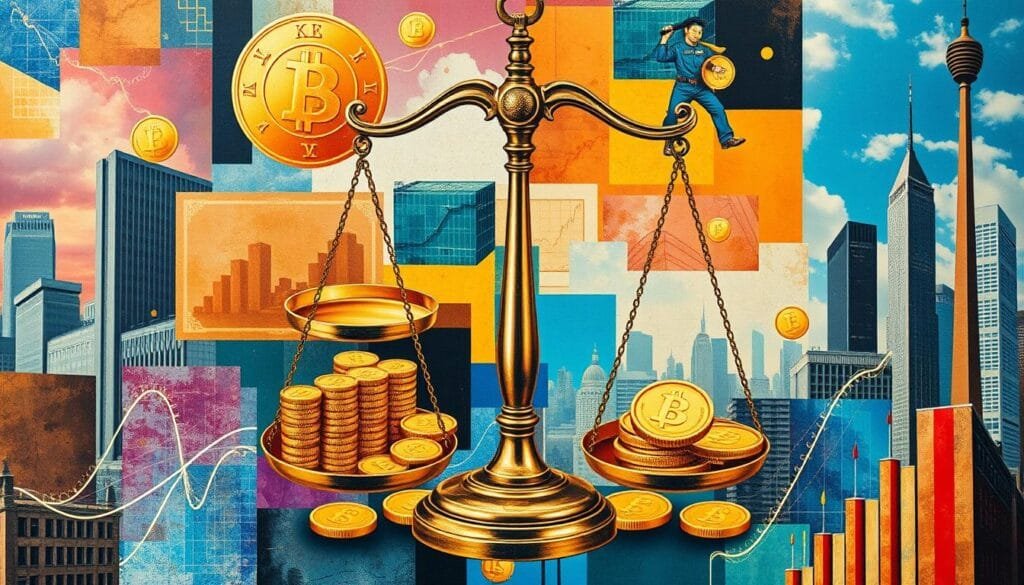Have you ever wondered why markets behave the way they do? The rules that guide market behavior were set over a hundred years ago. These old theories still shape our policies, business strategies, and everyday buying choices. By learning about neoclassical economics, we can understand its importance in today’s economy.
The term “neoclassical economics” comes from the American economist Thorstein Veblen in 1900. By then, English-speaking economists agreed on key theories about value and distribution. This agreement started an era influenced by big names such as Adam Smith, David Ricardo, Thomas Robert Malthus, and Karl Marx. The Marginal Revolution in the late 19th century confirmed these fundamental ideas of neoclassical economics.
Neoclassical economics explains decision-making by economic players. It says buyers and producers aim to get the most benefit within their limits. This thinking leads to a balance in the market. Prices adjust based on supply and demand, matching what households and businesses want.
Key Takeaways
- The concept of neoclassical economics was formalized by Thorstein Veblen in 1900.
- Understanding market theories and consumer behavior economics provides insight into how modern markets operate.
- Neoclassical economics emphasizes rational choice theory and utility maximization.
- This theory posits that prices serve as signals for reconciling conflicting desires among economic agents.
- Key historical figures include Adam Smith, David Ricardo, and Thomas Robert Malthus.
- Neoclassical synthesis, combining Keynesian and neoclassical theories, dominated mid-20th-century economics.
Introduction to Neoclassical Economics
Neoclassical economics is a key part of economic theory. It’s built on the history and ideas of major economists. By exploring its roots, we understand its impact on today’s economic thinking.
Historical Background
The growth of neoclassical economics began in the late 1800s. It was shaped by economists like David Ricardo, Alfred Marshall, and Thorstein Veblen. Veblen coined the term “neoclassical economics” in 1900, marking a new phase in economic thought.
Throughout its history, neoclassical economics has focused on efficiency, rationality, and balance. It has adapted through big economic downturns like the Great Depression and the 2008 financial crisis.
- The main issue in neoclassical economics is how to best use limited resources.
- It values rationality, selfishness, and equilibrium, known as the “Holy Trinity”.
Key Contributors
Neoclassical economics has evolved thanks to several key thinkers. Alfred Marshall brought in ideas like marginal utility, which helps in making choices. His work laid the foundation for later economists.
Vilfredo Pareto introduced the concept of Pareto efficiency. This means an economic state is good if no one can improve without hurting others. This idea is still used to judge economic results.
| Contributor | Key Contribution | Impact |
|---|---|---|
| David Ricardo | Comparative advantage | Provided a framework for international trade |
| Alfred Marshall | Marginal utility and costs | Developed the supply and demand model |
| Thorstein Veblen | Coined “neoclassical economics” | Modernized classical economics through analytical methods |
| Vilfredo Pareto | Pareto efficiency | Critical in economic welfare evaluations |
These great minds didn’t just shape micro and macroeconomics. They also improved econometrics, the math economists use. Together, their work keeps neoclassical economics vital in solving today’s economic issues.
Core Principles of Neoclassical Economics
Neoclassical economics relies on key ideas about market behavior and economic results. It has three main principles: rational choice theory, utility maximization, and market equilibrium. Let’s dive into these basics.
Rational Choice Theory
Rational choice theory is central to neoclassical economics. It thinks people make smart decisions to increase their happiness. People consider the pros and cons before choosing what makes them happiest. This idea matches neoclassical economics’ focus on using resources well.
Utility Maximization
Utility maximization is crucial in neoclassical economics. It suggests people want to get the most happiness from goods and services. This idea is behind many models of how consumers act. According to neoclassical theories, everyone’s pursuit of happiness is different. To learn more, check this detailed explanation.
Market Equilibrium
Market equilibrium is important in neoclassical economics. It’s when supply meets demand, leading to stable prices and amounts. Neoclassical theories say markets naturally reach this balance. In a perfect market, this balance helps companies earn the most while letting consumers get the greatest happiness.

Neoclassical economics started in the late 19th century. It is based on ideas like rational choice theory, utility maximization, and market equilibrium. These concepts help analyze market actions and economic results. Learning about these principles shows their big impact on today’s economic thinking and activities.
The Role of Supply and Demand
Supply and demand are key to understanding economics. They affect how prices are set and how markets work. Knowing how they interact helps people make better economic decisions.
This interaction shapes our economy. It influences market dynamics and how businesses evolve.
Supply and Demand Interaction
The balance of supply and demand sets prices in the market. If there is more supply than demand, prices go down. This makes people buy more and suppliers might make less.
But if demand is higher than supply, prices go up. This encourages more production to meet the demand.
History shows us examples of these principles. After World War II, the U.S. saw changes in inflation and jobs due to supply and demand. In 1975, things were stable with both inflation and unemployment at 3%. But by 1985, unemployment was up to 6% and inflation was at 1%, showing how complex these interactions can be.

Impact on Pricing
In the 1990s, supply and demand changes challenged businesses and policymakers. They had to adjust their strategies. For instance, in 1995, with less supply, prices went up as inflation hit 4% and jobs were plenty at a 2% unemployment rate.
The 2008 financial crisis highlighted the need to understand supply and demand. Market failures caused by bad information led to a downturn. Pricing needed careful adjustments to keep markets stable. These events show why it’s vital to understand and respond to economic changes.
What is the Objective of Neoclassical Economics
Neoclassical economics is over 150 years old but still key in today’s economic thinking. It started in 1900, thanks to Thorstein Veblen. It aims to use resources well, solving a major economic issue. This theory looks at how families and businesses (microeconomics) and overall economic trends (macroeconomics) interact. It aims for economic efficiency.

This theory’s built on methodological individualism, instrumentalism, and equilibration. These ideas help it focus on markets working well and making consumers happy. Utilitarianism guides it, demanding trade-offs for the best outcomes.
It mixes individual preferences to find where demand meets supply, thanks to pricing. This balance, or market equilibrium, results in Pareto efficiency. That means no one can get better off without hurting someone else. It’s a delicate mix of keeping consumers happy and economy effective.
David Colander talked about neoclassical economics in 2000. He mentioned its three main ideas in 2004: rationality, selfishness, and equilibrium. These are crucial for making more money, he said. They form the base of economic theories and policies.
In places like Germany, half of the people own just 1.3% of all wealth. The gap between rich and poor is huge. Fixing this could help society a lot. It could cut down on mental health issues and reduce the number of people in jail.
In summary, neoclassical economics helps manage and distribute resources systematically. It aims for economic efficiency, market functionality, and consumer satisfaction. Its ultimate goal is to increase profit maximization.
Real-World Applications of Neoclassical Economics
Neoclassical economics shows us how economies work. It plays a big part in devising business strategies and government policies. It helps those in charge make smart choices in our modern marketplace.
Business Strategies
Companies use neoclassical ideas to improve their work. They focus on meeting market needs in smart ways. This boosts their profit and standing among competitors.
For example, the 1980s saw tax cuts aimed to increase spending and investments. This moved the market and changed how businesses operated. Even today, companies apply these ideas to be more efficient and successful.
Government Policies
The government also relies on neoclassical economics. The American Recovery and Reinvestment Act of 2009, worth about $800 billion, showed this. This plan tried to fix the market and encourage growth by spending more in key areas.
Although such economists usually prefer less spending, during the crisis, a lot was spent on health, infrastructure, and education. This aimed to lift the economy.
Neoclassical theories have a strong effect on how money is managed too. After the big recession, the Federal Reserve cut interest rates to nearly zero. This showed the challenges of managing the economy in tough times. More than 85% of central bank decisions use these ideas.
Looking at different situations shows the power of neoclassical economics. Post the 2007–2009 recession, the Federal Reserve studied its effect on jobs and the economy. This proactive approach is backed by neoclassical thinking. Many experts and school courses still focus on these ideas, proving their importance in facing economic difficulties.
| Application | Example | Impact |
|---|---|---|
| Business Strategy | 1980s Supply-Side Tax Cuts | Increased Investment & Consumption |
| Government Policy | ARRA 2009 | Stimulus for Healthcare, Infrastructure, Education |
| Monetary Policy | Post-Great Recession Interest Rate Reductions | Illustration of Liquidity Trap |
| Fiscal Policy Impact | Aggregate Demand Management | Proactive Economic Management |
Criticisms of Neoclassical Economics
Neoclassical economics is a big player in economic theories but often gets criticized. These critiques say it doesn’t work well with real-life situations. This text explores the main critiques and how they make neoclassical economics less credible.
Unrealistic Assumptions
One big issue with neoclassical economics is its unrealistic assumptions. It thinks individuals act perfectly rationally and know everything they need to. But this isn’t how people behave in real life. Decisions are more complex and often not fully rational.
These wrong assumptions can lead to policies that don’t solve societal problems. It’s why understanding human behavior is key to better decisions. Behavioral economics shows us how real people act, which is often unpredictable.
Over-Reliance on Mathematical Models
Neoclassical economics loves its mathematical models. These models try to predict what will happen in economies. But they struggle to grasp human behavior and social dynamics. This leads to predictions that don’t always match what happens in real life.
When statistical controls in studies aren’t right, it makes findings unreliable. This questions if policies based on these models are any good. It shows the need to check how well these models truly fit our world.
Ignoring Behavioral Economic Insights
Another critique is ignoring what we learn from behavioral economics. Neoclassical models focus a lot on equilibrium and efficiency. But they miss out on how psychology and society affect economic decisions. Factors like trust and social preferences do impact markets.
Thorstein Veblen pointed this out over a hundred years ago. Organizations today, like WEAll, say we need to change economic systems to include social justice. This shows missing out on behavioral insights makes policies less effective.
In conclusion, these critiques spotlight major flaws in neoclassical economics. They stress why adding behavioral economics to the mix is essential. By doing this, we can create economic systems that better match real human behavior and social structures.
Conclusion
Neoclassical economics has greatly influenced today’s economic thoughts. It builds on the ideas of rational choices, utility maximization, and market balance. These concepts have shaped business tactics and government approaches. Still, this school of thought faces critiques. Mainly for its assumed conditions and heavy reliance on mathematical formulas.
The Great Recession showed the strengths and weaknesses of various economic theories. In 2008, the GDP fell by 3.3% and then slightly in 2009, leading to significant job losses. The American Recovery and Reinvestment Act played a key role in softening the recession’s impact. It proved that insights from different economic theories are valuable. Despite neoclassical economists’ push for minimal government meddling, the recession highlighted how crucial strategic policies are during financial crises.
As we look ahead, we see the flexibility of neoclassical economics is significant. It now covers theories that can be tested on many fronts, pointing towards its ongoing growth. Yet, it’s not without its critics, particularly against the backdrop of behavioral economics that showcases the complexity of human decisions. Embracing a mix of viewpoints will be key. This will help create comprehensive strategies to meet our global economy’s changing needs.
FAQ
What are the main objectives of neoclassical economics?
Neoclassical economics looks at how resources are used and aims for economic efficiency. It also studies market actions. This area includes topics like consumer behavior and market theories.
What is the historical background of neoclassical economics?
Born in the late 19th century, neoclassical economics grew from classic economic ideas. It highlights the benefits of market operations. Keywords include its history and the development of economic theories.
Who are the key contributors to neoclassical economics?
Alfred Marshall, William Stanley Jevons, and Léon Walras are key figures. They helped shape neoclassical thinking. They are linked with economic theory growth.
Can you explain the core principles of neoclassical economics?
Its basics cover Rational Choice Theory, Utility Maximization, and Market Equilibrium. These ideas explain decision-making by consumers and firms. Important terms are rational choice and market balance.
How does the Rational Choice Theory work?
Rational Choice Theory suggests people make smart, beneficial choices. They weigh the pros and cons. Key terms include rational choice and economic basics.
What is Utility Maximization?
Utility Maximization means people spend to get the most happiness. It’s crucial for grasping consumer actions. Keywords: utility maximization, basic economic principles.
What does Market Equilibrium mean?
Market Equilibrium happens when demand and supply balance out. It shows a stable market. Keywords are market balance and economic basics.
How do supply and demand interact in neoclassical economics?
The supply and demand dynamic sets market prices and amounts. They adjust to reach market balance. Terms include supply and demand rules, and pricing.
What impact does supply and demand have on pricing?
Supply and demand strongly influence prices. When demand is higher than supply, prices go up, and vice versa. Key terms: price effects, supply and demand rules.
What is the primary objective of neoclassical economics?
Its main aim is economic efficiency. This ensures the best use of resources for maximum satisfaction and profit. Key areas include market efficiency and consumer happiness.
How are neoclassical economic principles applied in the real world?
These theories guide business and government actions on market rules, taxes, and financial policies. They’re key in business and policy-making. Related areas include market management and economic legislation.
What are the criticisms of neoclassical economics?
It’s critiqued for too much math, unrealistic views of human behavior, and overlooking behavioral economics. Topics include its shortcomings and behavioral economics insights.
What are some unrealistic assumptions made by neoclassical economics?
It often assumes perfect knowledge, rational actions, and efficient markets. Critics highlight these unrealistic ideas. Related issues include economic critiques.
How does neoclassical economics rely too much on mathematical models?
Critics say too much math simplifies complex economic realities. This leads to criticisms of its approach. Keywords include math dependency and critique of economic models.
Why do some economists prefer behavioral economics over neoclassical economics?
Behavioral economics looks at how thoughts, feelings, and society impact choices. This gives a fuller understanding of actions. It challenges neoclassical views by including psychological aspects.
